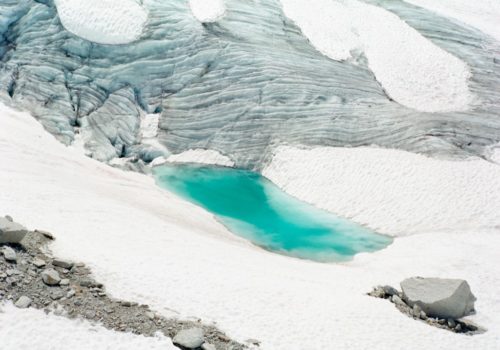Who invented mountains landscape? Romantic literature, with its fascination for the sublime? Painting? Engraving? None of the above: the credit for popularizing the theme in the late nineteenth century, just as tourism and mountaineering were taking off, goes to photography. There is nothing like an infinitely reproducible image to sell one of the most beautiful natural sights.
At least this is the claim of the exhibition Sans limites: Photographies de montagnes at the Musée de l’Elysée in Lausanne, Switzerland. This is the last exhibition by chief curator Daniel Girardin who is retiring after three decades at the Swiss institution. As can be seen from his introduction, Daniel Girardin thinks big. Amassing some 300 photographs, many monumental in format, the display sprawls across three floors. The majority of the prints come from the museum’s own collections. There are pioneering works by Francis Frith, Adolphe Braun, Jules Beck, William Donkin, Emile Gos, a few photographs by Tairraz, one by Boissonnas, as well as René Burri.
Mountains, mountains, mountains. At first glance, diversity is not the exhibition’s strong point. Its interest, however, resides in its attention to the photographers’ intentions and visual strategies developed on snowy peaks in the early days of this new technique, even if it meant hauling 550 pounds worth of equipment, including a portable lab, as Auguste Rosalie Bisson did in the 1860s.
These were the heydays of travel photography—a timely response to the democratization of tourism and facilitated access to the Alps. The theatrical landscapes of Switzerland and Savoie were being equipped with roads, railroads, and hotels. Photography became the medium promoting these beautiful vistas. Photography was also scientific in cataloguing geological and glacial formations on the precipitous slopes. Soon, photography paired with mountaineering, proudly displaying what used to be out of reach. Lastly, photography continued to be artistic with the emergence of pictorialism and New Photography.
In that regard, the exhibition surveys the full spectrum of photographic approaches, including giant digital prints by contemporary artists (Matthieu Gafsou, Jacques Pugin, Thomas Bouvier, and Maurice Schobinger). These modern oversized formats correspond to large glass plates of the early mountain photographers whose ambition was similarly to show the hieratic character of their subject.
The exhibition is in itself a small history of photography. It enumerates the techniques used high in the mountains, from the daguerreotype to the wet-collodion process, from stereoscopy to the panorama, from gelatin silver to digital prints. The exhibition is attentive to angles of view, which are classified depending on the choice of portrait or landscape layout, aerial views, or distant scenes. It also distinguishes cones from icons, starting with the Matterhorn and the Mont-Blanc.
Sans limites certainly could have addressed at greater length the newly gained awareness of the fragility of mountains, which are an early warning sign of global warming. However, the exhibition’s thorough historical and aesthetic approach speaks so well in its favor that one would be remiss to give up the climb.
Luc Debraine
Luc Debraine is a culture and society correspondent for the Swiss magazine L’Hebdo in Lausanne.
Sans limites. Photographies de montagne
January 25 to April 30, 2017
Musée de l’Elysée
18 avenue de l’Elysée
1006 Lausanne
Suisse
Catalogue of the show published by Les Editions Noir sur Blanc.
















